Hello everyone:
Given the name of my writing project here, I should note that a geological committee has, for now, voted down the proposal to name a new Anthropocene epoch on the geologic time scale. To be clear, though, they do not oppose the idea of the Anthropocene. The planet-shaping reality of our impacts isn’t in question. What a majority of committee members opposed, for technical reasons, was the dating of the Anthropocene to the mid-20th-century. Humans, after all, have been modifying the planet at scale for far longer than that. So the scientific discussion continues, even as the transformation intensifies. “We are in the Anthropocene, irrespective of a line on the time scale,” one scientist told the Times. “And behaving accordingly is our only path forward.”
A reminder: For those of you interested in listening to rather than reading these Field Guide essays, I have finally recorded a few recent ones: Running AMOC, Who is We?, and Consciousness is Organic. You can also find them by clicking on the Field Guide’s podcast tab. These read-alouds are very much a work in progress – especially my vocal work – and they only cover the main essay. For the full Field Guide experience, reading is still the way to go, since the essays contain the photos, graphics, and curated Anthropocene news that the audio does not.
As always, please remember to scroll past the end of the essay to read this week’s curated Anthropocene news.
Now on to this week’s writing:
Winter here in midcoast Maine is over. We might yet see a flurry, maybe even a rogue fluffy storm, but the season is behind us. Rain that should be snow falls on bare ground. The mosses and lichens are damp and glowing and the lawns are brightening. Mud season has arrived, and so have the disease-carrying ticks who now thrive where, half a century ago, they could not survive. We are surrounded by reminders that a warmer world is a very different world.
But I want to take a moment to celebrate and appreciate a New England winter before it becomes a pale memory in a hot green spring. Despite the accelerating reports of the warmest months, years, and ocean temperatures in recorded history, I’ll keep my muttering about the larger shift that’s happening to a minimum and focus instead on just how intensely beautiful and vital a winter world can be.
In order to perform the necessary task of thriving in the Anthropocene, we must first remember and be in love with the world that we’re losing. I hope these pictures and words help you do that. Enjoy.
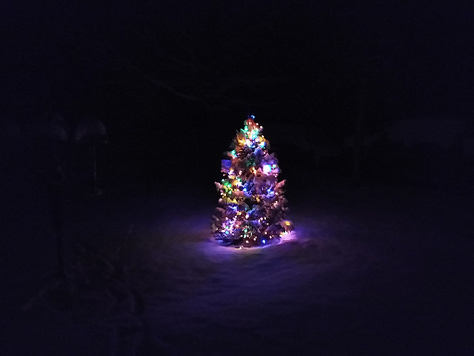
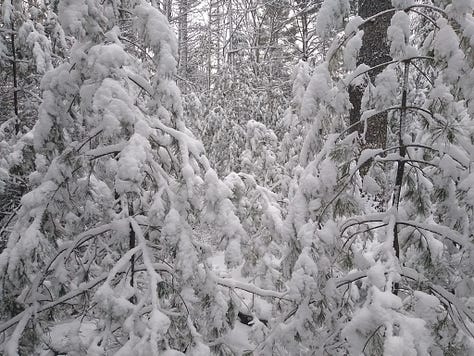
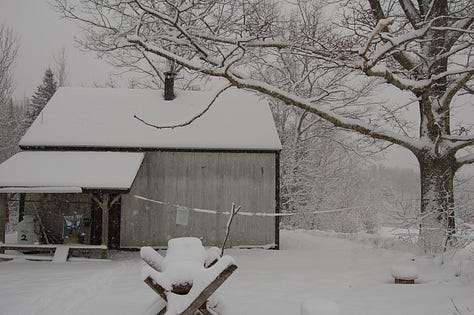
Snow as Blanket, Snow as Hardship
The first snow arrives like a knock at the door. For the young and the fortunate, it’s the announcement of holidays to come, the white page of the greeting card yet to be inscribed. For the homeless, or those in thin-walled houses heated by hard-earned wood or expensive oil, it’s an interrogation: Are you ready? Will you be warm enough? Can you get by til Spring?
My great-grandmother, as the story goes, used to grumble as the first flakes fell: “Look at all that snow dirtying up the ground.” If you’d grown up in the deep snow and deeper cold of downeast Maine in the late 19th century, you might feel the same. Snow and frozen ground were a burden on the land if you thought the land was yours to use. As in millennia past for the Wabanaki and other peoples, winter for the new arrivals was an existential challenge.
But even if winter is a difficult and dark magic, it’s still magic. Long black starlit nights sleep on glowing blankets of snow. Conifers stoop, shouldering their white burdens while ornamented by the birds who remain. Hardwoods stand skeletal in a bitter wind, reaching from the bone-colored Earth into the emptiness of a cold sky.
And while nothing is truly empty, especially here on Earth, winter feels like a metaphor for the hard vastness of space and the mysterious space within the atoms and particles that constitute both our bodies and the star we have turned away from. Life is the anomaly in a universe of cold physics, and we remember this when winter knocks and we open the door to silence.
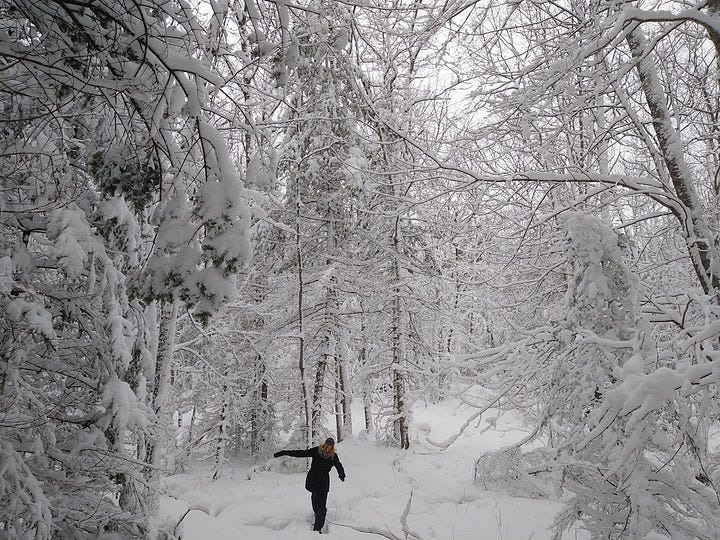
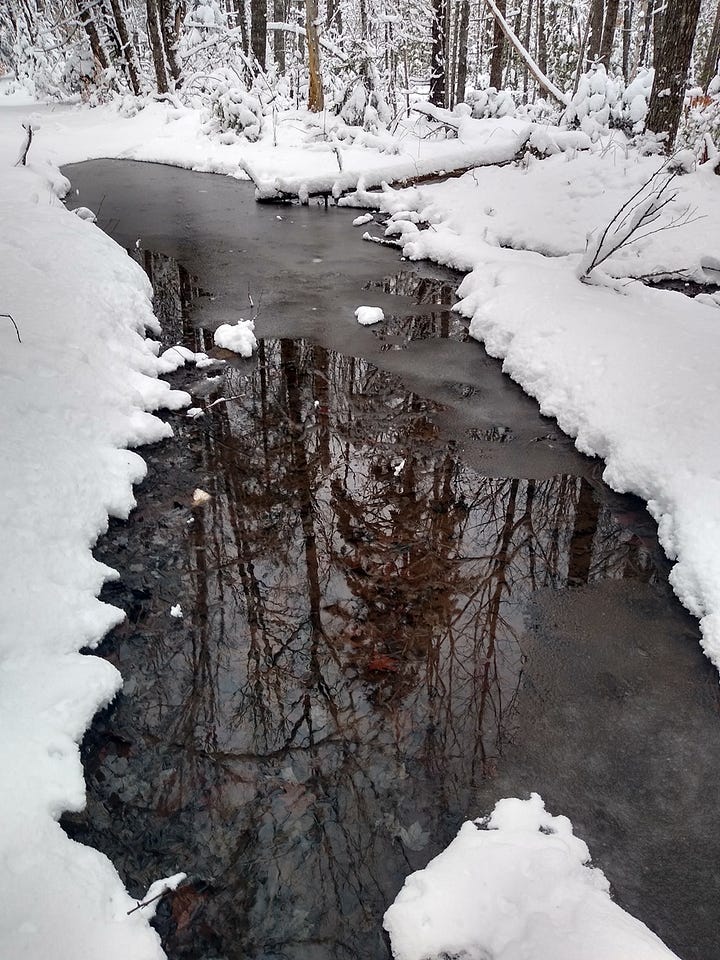
Walking on Water
We spend the winter walking on water, though we scarcely think of it that way. The miracle of snow and ice and cold and dark is in the tension between transformation and transience. The world is transformed by the sleight of hand that water performs, shifting between solid and liquid and vapor with a mere touch of the thermometer.
The joys of skate and ski and sled rely on the magic of water. We warm our bones while gliding across microscopic melt layers on crystals that briefly glisten. We snowshoe across or plunge knee-deep through a substance that, on a warmish day, disappears like fog in the sun.
I long ago gave up downhill skiing and took up cross-country. I want to be with the quiet winter woods rather than accelerating through them in a crowd. But I love walking most of all, trudging through this alternate universe, stopping and listening to oak branches clacking in a bitter wind.
No other season offers such hard grace.
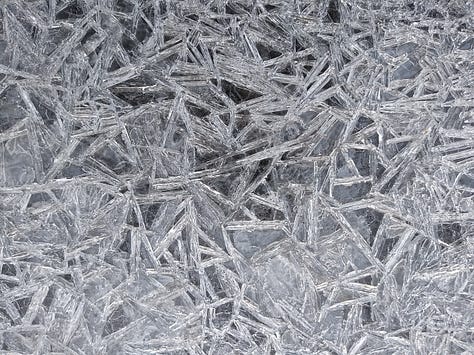
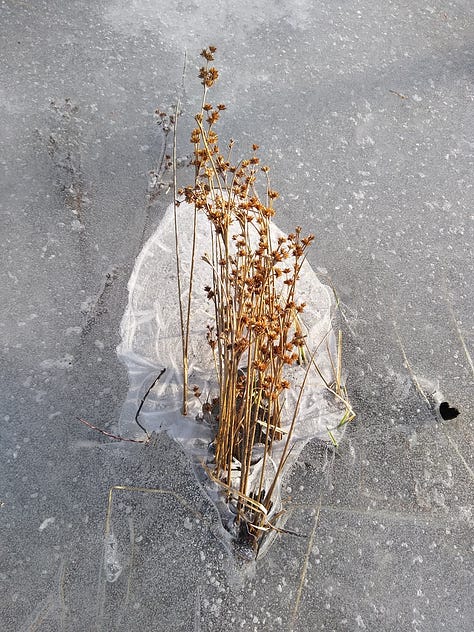
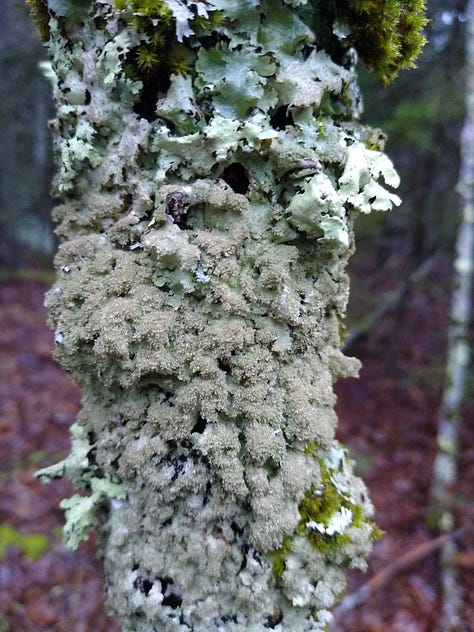
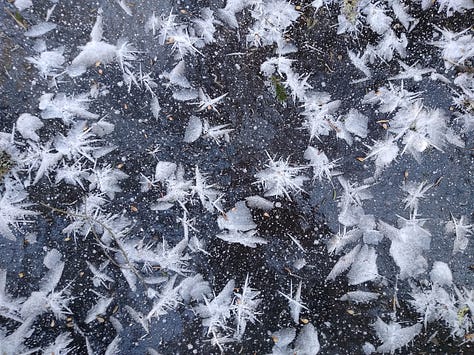
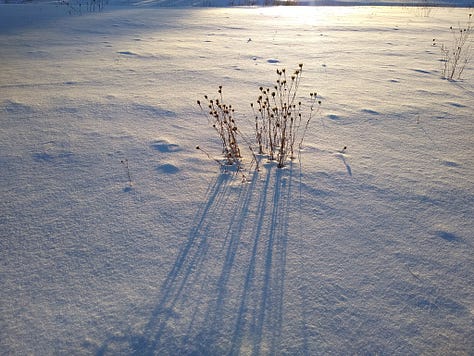
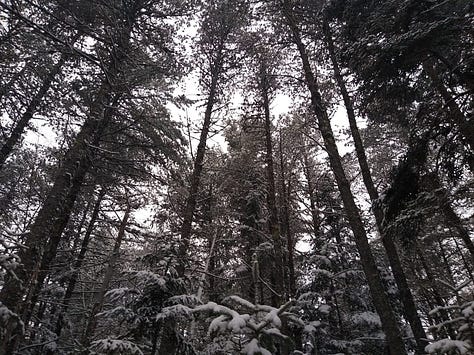
The Poetics of Thin Ice
We were once forcibly embedded in winter like a leaf in pond ice. It fell upon us like a weight or strange bounty. Now winter visits but does not linger. The worlds of high altitude and high latitude once descended into ours, making a desolate aerie even of the ice-locked lowlands. Now we look up through addled atmosphere at mountaintops whose own snow and glacial ice drains away to valley and sea.
Still, though, when it’s here winter helps us recalibrate how we define beauty. Winter weeds stand as elegant, dry bouquets against the white expanse. The blue and blank canvases of ice and snow make an island of each tree and shrub, their moss- and lichen-touched bark no longer hidden among the greens and browns of the living seasons, their buds each a tight glossy miracle, and their forms an elegant dark dance in their reach for light. Winter light reaches what stands both slantly from above and softly from below. Bark, especially, reveals the nuances of earthly colors while fashionably flaunting a designer line of crustose, squamulose, foliose, and fruticose lichens.
As Thoreau wrote once in his journal, “The dry grasses are not dead for me. A beautiful form has as much life at one season as another.”
Even thick ice is thin ice when we factor in time and awe. We skate across a moment in time and a childlike joy as much as we skate across a transparent substance pocked with bubbles trapped like clouds in a photo.
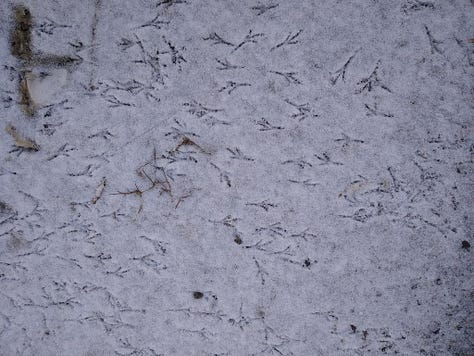
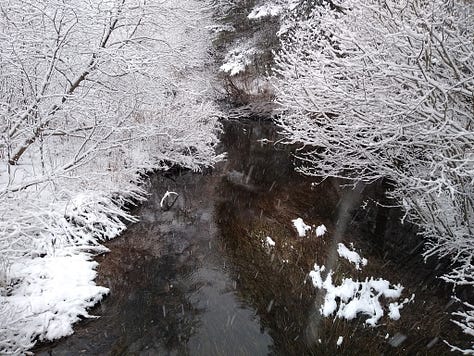
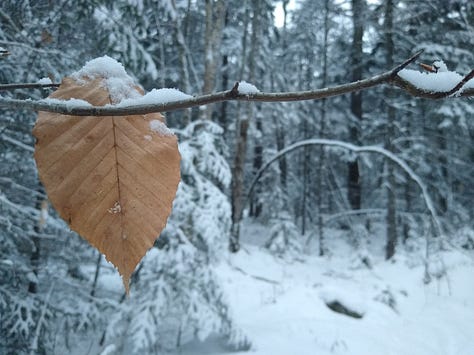
Shroud and Rebirth
From our warm boxed-in lives – house, car, office, store – we imagine winter as a burden on life. Cold kills, certainly, and winter storms break trees. If spring is the urge to celebrate, summer the gathering, and fall the feast, winter must be the absence of life, right? Not at all. Life evolved with winter, which is as essential to the feast as the Sun. A northern year does not have a steady tropical rhythm, but it has its own miraculous heartbeat.
The animals with enough fat will sleep and dream. Those who have stored food hunker down with it or visit it like misers to their hoards. Some birds visit our feeders, but even they spend most of their short cold days eating insects and larvae, seeds and berries. Wood frogs and others enter a quiet state of being as mysterious as that of a microbe on Titan. Foxes, coyotes, and snowy owls punch through snow to hunt for mice and voles in the paths of the subnivean zone, while weasels and shrews stalk the paths. Deer treat themselves to the usnea lichens decorating winter-snapped trees. Buds formed in autumn will wait on twigs all winter, each one a gamble and a promise, gestating for the world to see and for foragers to eat.
What we think is a white shroud is a blanket, a reservoir, a home and as much a promise as the return of the Sun, a promise fulfilled as snow melts into stream or rises into mist to reveal the anteroom to spring.
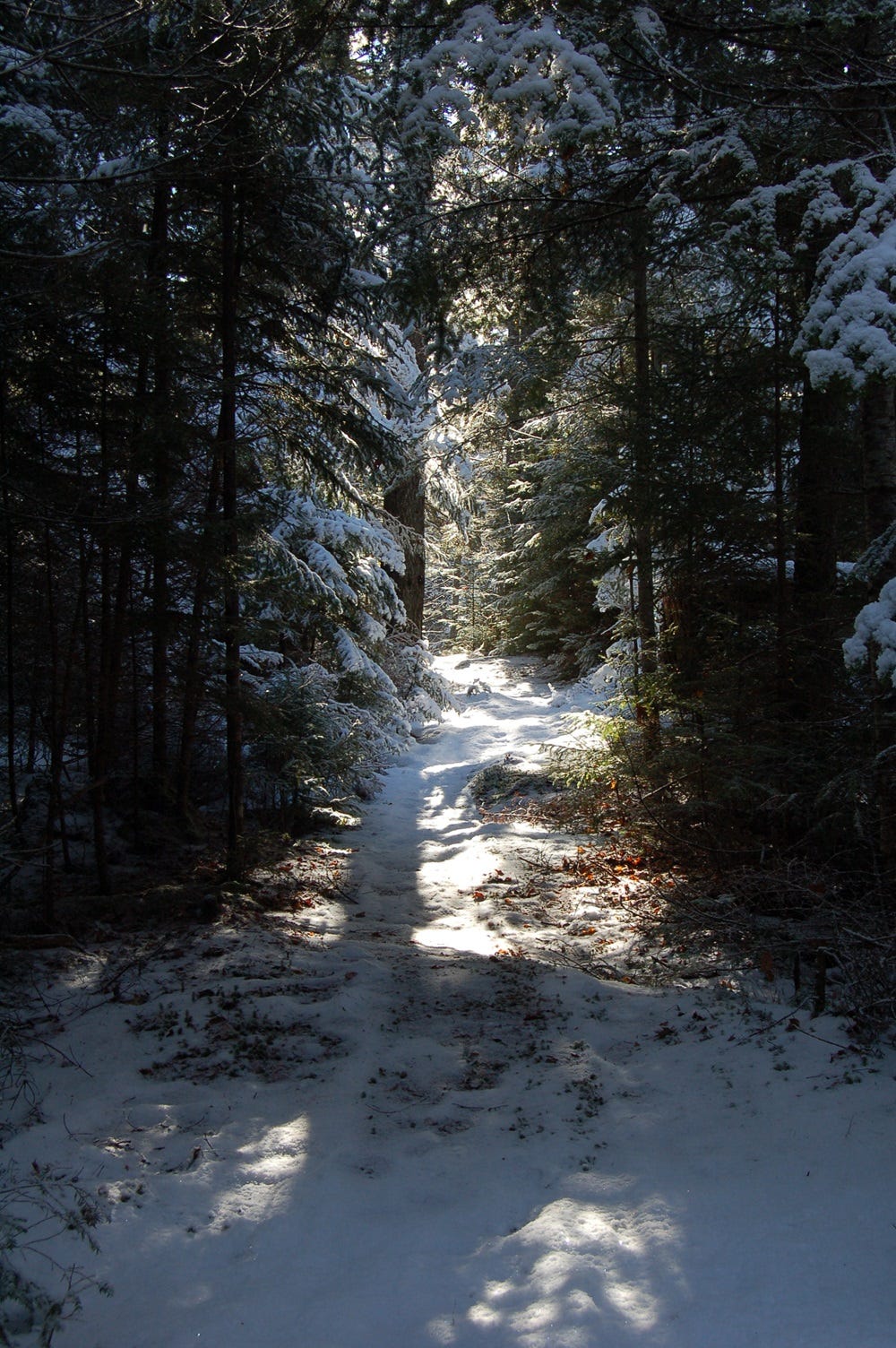
Apricity
Have you ever enjoyed the feeling of a warm sun in winter? That solar winter warmth is apricity. I learned the word recently, and it got me thinking of the joys of coming in from the cold, which in turn reminded me of my grandfather (the one who married the daughter of the woman who hated snow). I was about fifteen, and we were miserably cold in a miserably cold rain one early spring day, fishing in an open boat on a lake on the Canadian border. After hours of few words and fewer fish, he turned to me and said, slowly, “I wish I was home in the woodshed, because then I’d go in the house.” It will mean little to you here, but in the moment it was a perfectly delivered bit of downeast humor, and I just about fell out of the boat.
We need to know the cold to appreciate the warmth. Winter poses hard questions to which spring offers easy answers. We need to hold winter in our cupped, numb hands to know how it feeds us both later in the year and later in life.
As ice breaks and snow melts, we feel energy surging from the Sun through the landscape and our own cells. “The day has opened its eyelids wider,” as Thoreau put it. The north country turns its face upward as sap flows toward buds and migratory life moves up the ladder of longitude. What was once blessed with the silence of winter now welcomes the turbulent blessings of spring.
I once celebrated the transformation of a winter river in my canoe. The ice was breaking into large floes, and I spent an afternoon with them. I’d paddle the bow of the boat up onto a floe that was spinning its way downriver. I floated and spun with the ice for a while, then backed off at the last second before the floe tumbled down through a rapid in a beautiful disintegration, water returning to water. Then I’d paddle back upstream and do it again. The world was silent except for the disintegration, which was really integration. The sun was warm on every face.
You will have your own winter stories, joys, aesthetics, and hardships to share. Feel free to offer them up in the comments. There is so much I haven’t touched on here, from snowmen to animal tracks to winter ecology.
And I know that not all winters this year have been warmer and shorter. Some of you may be deep in snow right now; I hope you’re well and warm. For the rest of us in the north, a new Vox article explains how early spring is this year, why winter is more affected by a hotter climate than other seasons, and what the environmental consequences will be.
For anyone looking for an excellent, fascinating book on how life in the north country survives and thrives in the winter, I highly recommend Winter World by Bernd Heinrich.
Whatever season you find yourself in, and whatever shape that season still has, look at it closely and learn to love it. It’s all we have.
Thanks for sticking with me.
In other Anthropocene news:
From Macleans, a remarkable set of intensive urban high-rise developments are planned for Vancouver by the Squamish, Musqueam, and Tsleil-Waututh nations. This shift toward indigenous development autonomy has come after decades of hard work forcing the Canadian government to live up to its obligations, and arrives now despite opposition from non-indigenous neighbors who apparently expect the nations to revert to pre-contact ways of living rather than planning for a meaningful future for future generations.
From Benji Jones at Vox, a rare bit of good news about corals. While they are bleaching and dying across much of the globe – an estimated 70%-90% will be lost when we reach 1.5°C – corals in the Gulf of Thailand and East Asia more broadly seem to be fairly resistant to heat stress, due in part to the large number of coral species there and the deep genetic diversity within each species.
From Carbon Brief, a detailed Q&A on the European Union’s recently passed “nature restoration” law, which is meant to help the EU meet its biodiversity and climate goals. It recognizes that merely protecting nature is not enough; too much of the natural world is degraded and must be restored. Opposed by right-wing political parties, the law mandates that EU members restore at least 20% of the region’s land and sea areas by 2030. Beyond that, as Carbon Brief explains, the mandates are more specific and more ambitious:
Within this wider goal, countries need to restore 30% of habitats covered by the new law (including forests, rivers and wetlands) that are already degraded by 2030. This increases to 60% by 2040 and at least 90% by 2050.
And in related news from Carbon Brief, a thorough update on what has been accomplished in the year since the landmark Kunming-Montreal Global Biodiversity Framework was signed at COP15. As a reminder of what the Framework established, you can read my translation of the bureaucratic agreement from last year. Here’s Carbon Brief’s quick summary:
The Kunming-Montreal Global Biodiversity Framework (GBF) included four long-term global goals and 23 specific targets, with an overall mission of halting and reversing biodiversity loss by 2030.
Some of the key targets include conserving 30% of the world’s land and 30% of the ocean by 2030, reducing the impact of invasive species, cutting pesticides, sustainably managing agriculture and prioritising involvement of Indigenous peoples and local communities in different ways.
From the Guardian, a long well-written piece on the ecological importance of the deep sea, which makes up most of Earth’s habitable space, but remains shrouded in mystery even as it has become a dumping ground.
From Nature, “Why the world cannot afford the rich,” a data-driven essay on how stark inequality creates suffering in both human society and the living world.
From Hakai, “Dammed but not Doomed,” a moving story of the Passamaquoddy in Maine and the Peskotomuhkati in New Brunswick coming together to protect and restore fish habitat in the Skutik (St. Croix) River, which divides the U.S. and Canada. Specifically, they’re working to protect alewives, a river-run herring, with whom they’ve had a relationship for thousands of years.
Also from Hakai, a very brief write-up and graphic explaining the incredible amount of lost fishing gear – often called “ghost gear” – wreaking havoc in the oceans every year.
From @Anne Thomas of @Anne of Green Places, a wonderful exploration of the “tree of life” metaphor, with illustrations, some history, and a lot of enthusiasm.

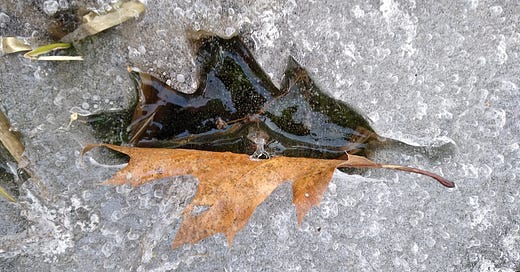



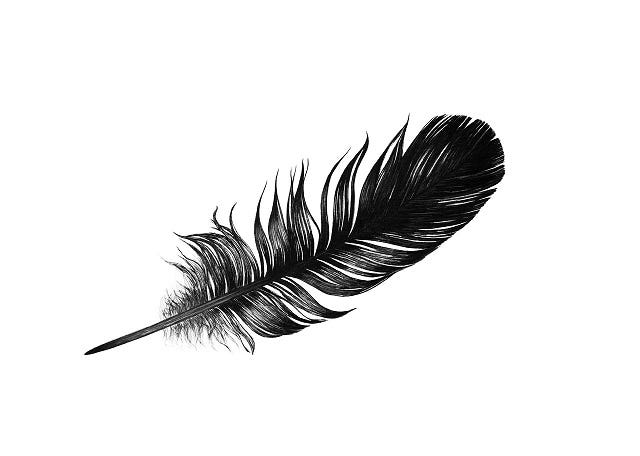
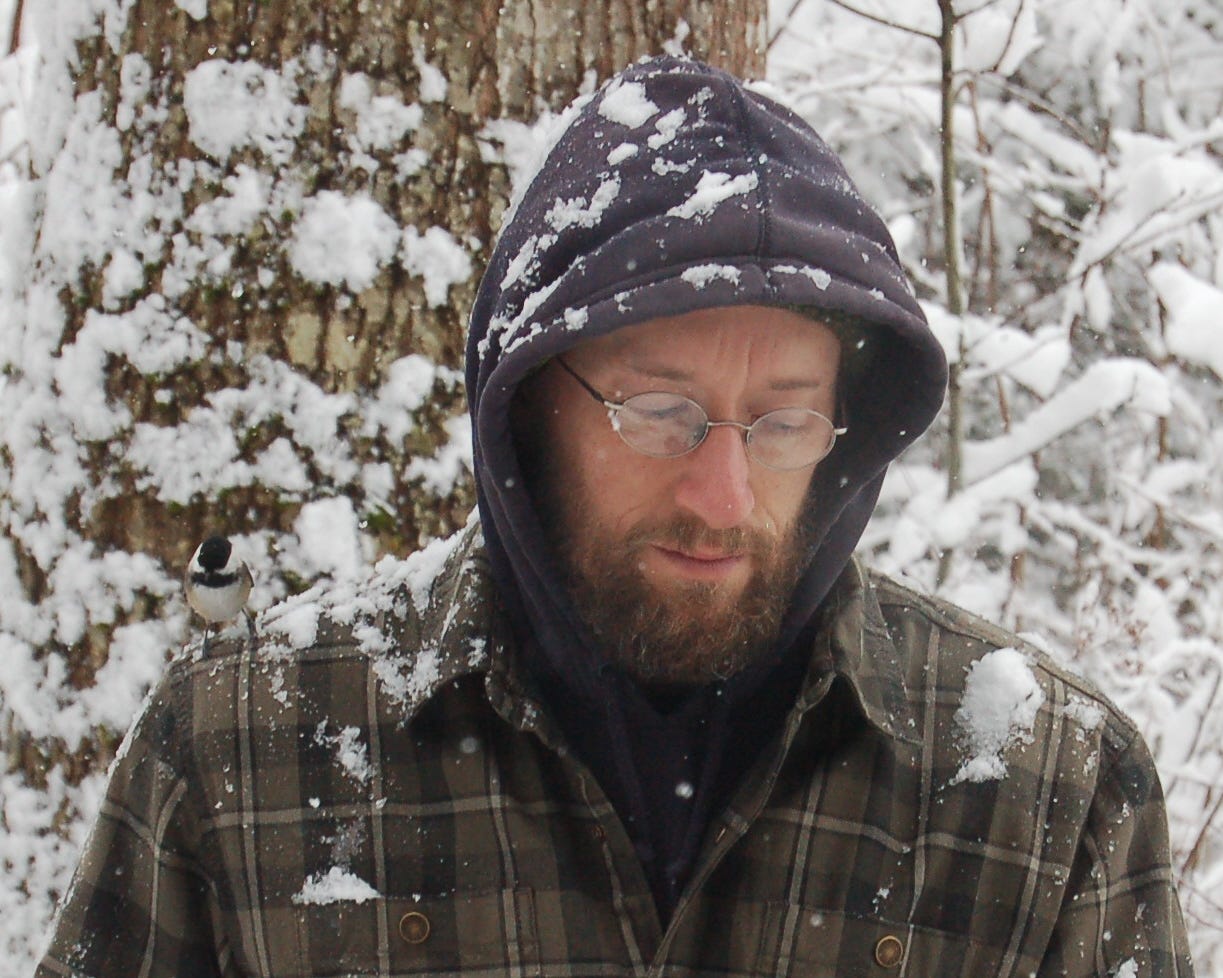

Hi everyone, I want to add another voice here. My friend Mark worked for decades outside as a carpenter in Maine, including during the often-bitter winters. He and Deb now spend their winters in FL. He says he's thought about spending a winter here now, but the winter he once loved doesn't exist. He beautifully articulates much of what I was after with this essay:
“What’s odd is knowing that it’ll never happen, not because I’m not around, but because winter isn’t… that “good stuff” is gone. Winter as I knew it, the winter I spent so many days and months and years with as an adult, the winter that worked its way into my body, mind and spirit, that occupied my soul from late November when it arrived with its challenge, until it moved on in early April every year… releasing me, taking its leave to my relief… departing with a warning whisper of “see you next year,” those winters are gone. As are the winters of my childhood, judging by the snow-filled slides my father and I have been going through. So it’s easier to be away from here during those months somehow. Because here may still be here… but it’s a different here now. I’m not around as much, and neither is winter.”
Jason, this is such beautiful writing. Every sentence is a little poem unto itself. And your photos hold the same poetic vision. I have been trying to write my own ode to the loss of winter here on the coast of Maine and have come up with only cliches. Absence as you so beautifully demonstrate is filled with abundance. I am going to print this essay out and read it slowly and treasure it.